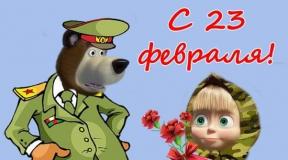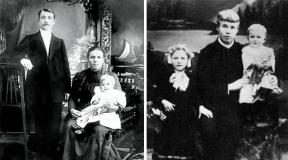Who is a werewolf? Who is a werewolf? There is a beast in everyone
The wolf in Russian folk tales is in most cases a negative character. He is a strong and dangerous opponent, but at the same time he is a naive and not particularly intelligent hero. He often gets into trouble because of his stupidity, maliciousness, and excessive trust in Lisa and other smarter characters. In rare stories, the wolf still becomes a true friend and protector.
Wolf in Russian folk tales
The positive and negative role of the wolf in fairy tales: its origins
The ambiguous portrayal of the character is associated with the same unclear attitude towards the animal among the people. In fairy tales, he often becomes a collective image, endowed with strength and stupidity at the same time. With the help of instructive stories, it is demonstrated that the physical strength of the enemy is not the main quality for winning a fight. This character is successfully complemented by the proverb “If you have strength, you don’t need intelligence!” But at the same time, when in a fairy tale the cunning Fox mocks the wolf, we empathize with him. His simplicity is closer to us than the cunning of the red-haired cheat.
The image of the simple-minded wolf is refuted in some fairy tales. For example, in the story about Ivan Tsarevich, the wolf hero, on the contrary, demonstrates wisdom, unexpectedly takes the side of good, and plays the role of an adviser and assistant. But this is the exception rather than the rule.
In their depiction of the fairy-tale wolf, people have strayed far from the real qualities of the animal. If the quality of cunning given to the fox, and cowardice to the hare, seem quite logical, then it is not at all clear why stupidity was attributed to such a dangerous predator. In nature, a wolf is an excellent hunter. He even brings some benefit as a forest orderly. The quality of straightforwardness attributed to him can only be associated with the fact that he is capable of facing danger eye to eye. His style of hunting also speaks of his ingenuousness: the wolf does not chase the prey for a long time, attacks more often in a pack and only on the weakest individuals from the herd.
The character of the wolf in folk tales
First of all, the wolf is a villain character. It’s just that in some fairy tales he poses a threat to other heroes, but in others he is harmless and even useful.
- “How the wolf was taught intelligence”- the wolf character in this story is stupid and lazy. He exhibits straightforwardness, which could be regarded as a positive trait if it were not associated with stupidity.
- "Wolf and Goat"- here he is a malicious deceiver, ruthless and greedy, but still not without naivety.
- "Sister Fox and the Wolf"- the wolf hero is depicted as a stupid and naive character who, despite his evil face, suffers from the tricks of Gossip the Fox.
- "Ivan Tsarevich and the Grey Wolf"- is portrayed as a conscientious villain who decided to compensate for his crime with a good deed and help a person with advice and deed. Here he is revealed as a kind and selfless character.
- "Wolf, Cat and Dog"- here the character demonstrates simple tricks, this is one of the few stories where his ability to deceive is manifested. Not as skilled as the Fox, but still capable of causing harm.
As you can see, the gray wolf is the most instructive, both in positive and negative forms.
Ideas about werewolves capable of turning into animals go back to the most archaic myths of different peoples. In particular, many epic heroes possessed such a gift. In the Middle Ages, werewolves became purely hostile, satanic characters and in this form penetrated into horror literature, and through it into fantasy and role-playing games. Recently, there has been a certain “rethinking” of the image of the werewolf as a creature close to nature and protecting it from people and monsters.
Half-breeds
The term “lycanthrope” (wolf-man - Greek) is not entirely correct, since the number of lycanthropes includes not only werewolves, but also many other werewolves, including werewolves (excuse us for these poor translations) and werecrocodiles. However, it has firmly taken root, and an attempt to retroactively “cancel” it is doomed to failure in advance. Carnivorous mammals form the basis for most werewolves, but there are exceptions. Absolutely all werewolves have character traits that resemble the behavior of the animals into which they transform, and even in human form, some elements of their appearance hint at their true nature. Most werewolves who turn into predators and vultures are evil and cruel, while lycanthropes - who turn into less aggressive beasts - are usually quite tolerable in any form. All lycanthropes can take the form of a human or a particularly large specimen of the animal into which they transform, some of them also have an eerie hybrid form that combines human or larger sizes and human body structure with animal features - fur, claws, muzzle. As a rule, werewolves are most dangerous in this form. Lycanthropes are only vulnerable to silver or magical weapons, some in all forms, others only in inhuman ones.

Non-Darwinian classification
There are two types of werewolves - true and infected. There are also results of curses and the effects of certain magical objects, but they are few in number. True werewolves are born lycanthropes and will die as such. Born from werewolf parents, they have full access to all of their werewolf abilities, and can change shape at will while maintaining complete self-control. Infected werewolves are ordinary people who have become lycanthropes as a result of being injured by a true werewolf. For the most part, they transform into another form for three nights a month - before, during and after the full moon, are unable to control themselves in animal form and do not remember anything the next morning.
It is possible to cure such werewolves, or rather, remove the curse.

Werebat represents a werewolf bat. In addition to its human form and giant bat, this creature can take the form of a skinny and long humanoid with the wings and snout of a bat, sharp fangs and sickle-shaped claws. These creatures live in remote caves in small families, often accompanied by dozens of common bats. They prefer to feed on people, but can tolerate a diet of other mammals.
Werebear (werebear) is one of the few “good” lycanthropes. These creatures are omnivores and lead a solitary life in deep forests. In human form they are distinguished by their enormous size and strength, but they do not have a hybrid form. Werebears are guardians of forests and rarely leave them in search of tools or hiring for service. Werewolves are their natural enemies.
Wereboar has a more explosive temperament than nitroglycerin. These creatures are paranoidly suspicious and see everyone as an enemy, and are prone to unmotivated cruelty. Short, coarse hair and a short but powerful body can give away a Werekaban in human form as surely as a violent character. The hybrid form of this werewolf is distinguished by a huge boar's head and a powerful chest and arms covered with stubble. Gigantic strength allows the monster to lift opponents with its hands and impale them on its tusks, which are terrifying even among ordinary boars.

Verelisa (werefox) unique of its kind. Only women can become Verelis, and all of them, regardless of race, quickly take on the appearance of silver-haired elves as a “human” form in a couple of years. This form is so beautiful that any man with average or less wisdom instantly becomes a slave to the grave. In its hybrid form, the verelis retains its elven body, but it is covered with silvery fur and gains a fox-like head and luxurious tail. Verelisa is a vain, comfort-loving creature who lives in solitude in the company of enslaved men and is no longer interested in anything.

Wererat is one of the weakest werewolves. Even in their hybrid human form with a rat's tail and snout, these creatures are small in stature and tend to use weapons. Wererats, like their smaller brothers, prefer to settle in the sewers of large cities, making a living by stealing and eating carrion. They love to feast on people, but the ingrained smell of sewage does not contribute to their success in society.

Werewolf, a werewolf, is the great-grandfather of all fantasy lycanthropes. Thanks to numerous horror films, his appearance and habits have become known to almost everyone. Werewolves have only one non-human form, but it can be different - for some it is a large wolf, for others it is an upright hybrid, for others it is something in between. Like spindlebugs, werewolves prefer the solitude of a narrow family circle, wandering through uninhabited forests and steppes and hunting people or other food. Of course, this only applies to true werewolves - those infected from their own family usually take the first victims.
Details
In the absence of the opportunity to squeeze even a small portion of the information available about werewolves into the module of the article, we will have to limit ourselves to only getting to know the “wolf” variety of werewolves.
So what do we know about them? Lycanthropes have many advantages over ordinary people. Thus, they are not susceptible to aging and physical diseases due to enhanced tissue regeneration. Therefore, they are practically immortal. However, they can be killed by fatal wounds to the heart or brain damage, as well as by hanging and strangulation.
Like real wolves, werewolves can remain alone for many years. However, the desire to join the pack often forces them to leave their secret refuge for a while. Then the werewolf is able to make a fatal mistake by confessing his essence to a priest or telling a close friend about it. Sometimes he acts smarter by turning another person into his kind so that he can become his companion.
A lycanthrope pack usually consists of a werewolf who has become one through magic, birth, or a curse—that is, he is a primordial cursed blood. Such a werewolf is called an Alpha. The rest of the pack are called Beta werewolves because they were bitten by the Alpha and carry his cursed blood.
Relationships in a pack are quite complex. If a person is bitten by a Lycanthrope, the victim's life is doomed to damnation. But a person retains hope of salvation until he tastes someone else's blood. If Alpha dies at the hands (teeth) of Beta, the curse on Beta is lifted. It must be remembered that, regardless of whether a Beta Werewolf was bitten by another Beta Werewolf or an Alpha Werewolf, the original source of the cursed blood must be killed to escape the curse. Interestingly, an Alpha cannot harm a Beta werewolf of his bloodline because at the same time he would harm himself in exactly the same way. But if a Beta werewolf is killed or injured by someone else, the Alpha will not be harmed.

Distinguish wolves from lambs
There are several characteristics of werewolves that allow them to be distinguished by their degree of danger.
"Wolf"- when a person transforms into a wolf, the first practically loses his mind and acquires the consciousness of an animal. He does not aim to kill his victims for the sake of killing, and does not attack if he is not hungry enough. If the transformation takes place in the lycanthrope's own home or apartment and he still retains partial memories of his human life, the werewolf will guard his home like a wolf protects his territory. If the transformation occurs in another place, he is extremely careful, realizing that this place may belong to another wolf.
The question of what part of human memory is retained in the consciousness of a werewolf during transformation does not have a clear answer. Sometimes a lycanthrope in the form of a wolf does not remember anything at all about his human existence. In other cases, he feels safer in the home, where he lives as a person and feels family ties with loved ones. And finally, he retains all the memory, but interpreted by the consciousness of the wolf.
"Daemon"- during transformation, he completely loses control over his hidden desires. Internal restraining motives completely disappear, and the lycanthrope turns into a “wandering demon,” committing cruel and terrible murders out of feelings of revenge, resentment, and hatred. He kills his wife, children, parents. After this, having returned to human form, he may not remember what happened to him. This is a very dangerous type of lycanthropy.
"Super" is a lycanthrope who, after transformation, completely retains the human mind and thinking. The least dangerous type of werewolf for people (provided, of course, that his behavior in a human shell is considered normal). However, the realization that he is in the body of a wolf can have a negative impact on his psyche.

How to turn into a werewolf
The main feature of a werewolf is the “wolf hair” on its head, noticeable from birth. You can also recognize a werewolf by the fact that the knees of their hind legs are turned forward, like those of a human, and not backwards, like those of an animal. When a werewolf approaches the water, what is reflected there is not a wolf, but a human image.
And how does the transformation itself take place from human to animal form and back? There are several methods of transformation.
The very first was “turning around” with the help of spells and rituals (“wisdoms”), and the most common was throwing. A person endowed with supernatural abilities becomes a wolf by “throwing over” (turning over) over a knife or ax stuck into a smooth stump or ground. They also throw themselves over a rocker, a stump, hoops, twelve knives, a rope, a tree branch, a fire on a stove, over the core of a fallen tree, or simply somersaulting “against the sun,” etc. Ordinary people, it is believed, can become wolves by stepping over a thing enchanted by a sorcerer. Also, in order to turn a person into a wolf, a sorcerer or witch throws an animal skin, ribbon or belt over him.
It was believed that particularly strong sorcerers could “turn entire wedding trains into wolves.” To do this, the sorcerer takes as many belts and cloths as there are faces on the train, whispers a spell over these things, and whoever he then girds with such a belt becomes a wolf. Sometimes a witch digs up the road for a train returning from the crown with a small ditch: as soon as the train runs into this depression, the horses fall dead, and people run away in animal form...
Also, those “transformed by the word of their mother” and children abducted by evil spirits become werewolves.
The transformation of an ordinary person into a monster almost always occurs during a full moon. The process begins with the fact that a person changes very quickly in appearance: the arms begin to swell and lengthen, the skin of the face and limbs becomes rougher and blurry. Soon shoes begin to interfere with your feet, your toes become crooked and tenacious. The unfortunate man's mind becomes darkened: he becomes uncomfortable, cramped in the house, and wants to escape outside. Then a complete clouding of consciousness occurs, the tongue refuses to obey, and instead of articulate speech, guttural muttering is heard. In this phase, the werewolf is completely overwhelmed by the thirst for blood, suppressing all other feelings. The man-beast runs off into the night, killing everyone in his path. Having satisfied his hunger, the werewolf falls to the ground and falls asleep, again acquiring a human appearance in the morning.
Here is one of the literary descriptions of such a transformation:
“I held Richard’s hands, and the fur flowed under my fingers, muscles swelled and fell, bones broke and knitted together. I screamed, trying to get out from under him, but the force was bending me down, filling me, and it seemed to me that my skin was going to burst, would not withstand it, could not withstand it.
He rose from me, not a wolf, but a wolf-man, covered in fur the color of cinnamon and gold. He looked at me with yellow eyes and extended his clawed hand, standing on slightly bent legs.
I didn’t take the hand and crawled back, stood on unsteady legs, not taking my eyes off him. In his wolf form he was taller, seven feet, muscular and monstrous. There was nothing left of Richard, but I knew how good it would be to release my beast to freedom. I felt the beast rising out of him like a second mind, a second soul, rising up, out, filling him and spilling out his shell.
And the body still tingled where this beast touched. The sensory memory of that softness of his fur under my fingers will haunt me from now on.” (Laurel Hamilton. "Deadly Dance").

There's a beast in everyone
In general, the Russian word “transformation” always has associations that are most suitable for myths, fairy tales, and magic. In English, the transformation process is usually called shifting or shapeshifting (literally “shape change”). Another English word, therianthropy, refers directly to the change from a human body to an animal body.
Some researchers divide therianthropy into physical and spiritual. In the latter case, a person, while maintaining a normal shell, changes his way of thinking from human to animal and begins to think like an animal. The signs of who he considers himself to be are as if embedded in him. For example, someone feels a wolf and a jaguar in themselves, another subconsciously strives to live in a pack or hunt alone. There are people who feel the instincts of the beast within themselves and are able to develop them at will, and then use such intensely expressed qualities as speed, reaction, increased sensitivity when perceiving the environment, dexterity, and strength.
Totems- these are animals that best reflect the character of a particular person. The uses of totems vary. This is especially noticeable when studying ancient cultures and shamanic customs, when some shamans pay great attention to the figures and colors of animal totems, while others ignore them.
There are two types of totems: internal (central) - the one that determines the essence of a person, and external - spirits that help a person and guide him through life. An internal totem is an animal, habits, habits, and lifestyle that suit you best. Some people compare themselves to a wolf or even a bear. The external totem guides you through life, like a guardian angel, and manifests itself in different ways, depending on what traditions you adhere to.
Fighting methods
What are the ways to counter werewolves? In the legends of all the peoples of the earth, a lycanthrope can be killed with an obsidian knife or an arrow with the same tip. Obsidian weapons are considered sacred and are used in many rituals. Another substance that has destructive power for a werewolf is silver. The Scots, the English, the Russians, the Africans, and the Indians kill their werewolves with silver weapons. It can be either a bullet cast from silver or a dagger with silver trim on the blade.
Of course, it is simpler and more merciful to kill any creature immediately, without subjecting it to unnecessary torture, but man, alas, is such an animal,
which in itself can be more terrible than any werewolf. The “Silver Collar,” or the so-called werewolf collar, was invented based on knowledge of the effects of silver on the body of a lycanthrope. It was invented as a weapon of retaliation, but extremely dangerous, because such a collar had to be put on a living werewolf, and it was considered a very effective means for those who wanted to delay time and mock the lycanthrope. It was designed very simply: sharp rivets were placed on a leather tape, later they began to be replaced with thin needles (not from the outside, but so that they stuck into the throat) made of silver, a certain ritual was performed (in Rus' such a thing was simply consecrated). Next, it was necessary to identify the werewolf, preferably during the full moon, and in the guise of an animal. If you put a collar on a werewolf, according to legend, he cannot turn into a human, but he will not be able to completely become a wolf - in other words, he will get a wolf the size of a man, and he will walk on his hind legs. He will not be able to remove the collar, and another werewolf will also be unable to help him do this, since the collar was riveted on both sides. Thus, according to legend, fathers took revenge for their daughters taken away by werewolves.

An image similar to a werewolf, a wolf-man, a werewolf, is in the beliefs of many peoples. Belief in wolves dates back to an era when it was possible to imagine a person in the form of a beast and when people, being in constant communication with the animal world, were able, according to the proverb, to “howl like a wolf with wolves”: oddly enough, chroniclers are really an art attributed to certain persons.. So, in the Laurentian Chronicle we read: “...and as quickly as midnight, Bonyak got up and drove away from the howl, and the wolf began to howl like a wolf, and the wolf rose up to him, and the wolves began to howl many times...”
One way or another, the idea that under the skin of a wolf there can be a man or a woman reflected the belief in the kinship and unity of all living things: here the wolf is the owner of the forest, animals and at the same time an older relative, patron, human ancestor, a “strong” sorcerer, wolf -magician Man, in turn, is a “transformed wolf” who draws strength from this kinship, and at critical moments in life can again take on the guise of an animal.
The werewolf is a mythical creature that existed in the legends of almost every nation.
This term refers to a person, spirit or demon who can transform into any animal and vice versa. Although it is generally accepted that werewolves in most cases take the form of wolves.
In this case, the transformation can occur either at the request of a person or become a consequence of certain factors: changing moon cycles, the smell of blood, the howling of animals, and so on.
What kind of monsters are these?
Initially, werewolves were people who were able to transform into various creatures, and even inanimate objects, with the help of magic and witchcraft. In most cases they were portrayed as some kind of monsters.
For example, among the Greeks, a werewolf was a skinny sorcerer with a donkey's head and a monkey's tail. Such “shifters” walk the streets on winter nights and scare people. But after the blessing of water, held on the feast of Epiphany, the world is cleared of these monsters until the next winter.
Different peoples have their own ideas about what animals a werewolf turns into. This could be a leopard, lion, fox, bear and even a seal, like the “silks” in Celtic mythology.
But still, for most people, a werewolf is associated with a wolf. Such a creature has many names: lycanthrope, werewolf, werewolf, mardagail, viltaki.
 It was believed that the transformation from man to beast occurs in different ways. If the werewolf is a sorcerer, then he could “put on” the animal’s skin at any time at will. At the same time, he retained his mind and thought logically in any situation.
It was believed that the transformation from man to beast occurs in different ways. If the werewolf is a sorcerer, then he could “put on” the animal’s skin at any time at will. At the same time, he retained his mind and thought logically in any situation.
If a person was bitten by a monster or a curse was placed on him, then he could transform at any time without his desire.
In most cases, the transformation occurred during the full moon, but it could be provoked not only by the light of the night luminary, but also by the smell of blood or the howl of another monster.
The transformation process itself is quite painful and at this moment the “changeling” is most vulnerable.
After conversion, the man could not control his instincts, and killed everything living in his path, while he did not remember anything about his “tricks.”
The appeal of werewolves
These monsters have many advantages over ordinary people. First of all, they are strong, resilient and fast, just like the animals they turn into. In addition, these monsters have other abilities:
- Tissue regeneration. It is believed that werewolves regenerate cells very quickly. Thanks to this feature, creatures do not age and are not susceptible to any diseases.
- Immortality. It is almost impossible to kill a werewolf, and the only danger for them is silver, and in those cases when the monster is wounded directly in the heart or brain.
- Cunning and knowledge. These monsters are dangerous because, even while in animal skin, they do not become stupid, and can use all the knowledge and skills that they had in human form. Monsters can easily outwit hunters, see the trap from afar and bypass all traps on their way to the victim.
These skills make werewolves excellent killing machines. And if you consider that the “changelings” in the legends had increased bloodthirstiness and mercilessness, then it becomes clear why people felt horror and at the same time respect for these creatures.
How to become a werewolf
 There are many legends about how to learn to turn into an animal. According to legend, you can become a werewolf in the following ways:
There are many legends about how to learn to turn into an animal. According to legend, you can become a werewolf in the following ways:
Apply a special magic spell;
Being bitten or scratched by a werewolf;
Take a sip of water from a wolf's trail, or drink from a pond used by a pack of animals;
Born on Christmas Eve;
Eat the brain or flesh of a wolf;
Wear clothes made from animal skin;
In addition, it was believed that the children of werewolves were able to transform into animals from birth.
At the same time, people who become “changelings” after a bite or curse can be cured. But only if they can withstand hunger and do not taste human flesh. Then you can perform a cleansing ritual and save the person.
If a werewolf tastes human flesh, then his soul is cursed, and he will be forced to wear the “animal skin” until his death.
In the mythology of many peoples, it is believed that a curse can be lifted by killing the monster that bit the person. In this case, all the victims of the werewolf become normal people again.
Myths about werewolves
Why did the wolf become a symbol of werewolves?
For many hundreds of years, this animal remained quite fantastic. And, despite the fact that his habits were quite studied, people did not stop endowing the wolf with incredible “devilish” intelligence and intelligence.
It was believed that the beast could hypnotize a person and that person would lose all will to resist and be rendered speechless.
The first legend about turning into a wolf appeared in the times of Ancient Greece.
One day Zeus decided to visit King Lykaon in the guise of a simple wanderer. But the cruel ruler ordered to kill the traveler in order to find out whether he was a man or a god. As punishment, Zeus destroyed the king's palace and turned him into a wolf for the rest of his life.
This is how the term “lycanthropy” appeared, meaning the transformation of a person into a beast.

But before, wolves were, albeit fantastic, quite revered animals.
Many warriors chose this beast as their totem.
According to legend, a man with the “soul” of a wolf had endurance, strength and speed, as well as intelligence, which made him invincible in any battle.
History contains many references to tribes living in different parts of the planet who considered themselves werewolves.
For example, the Balts had a caste of warriors who were servants of the wolf god.
Before each fight, these “werewolves” performed a special ritual, which included taking narcotic substances, henbane to be specific.
Under the influence of the plant, the warriors saw hallucinations about their transformation into wolves, and in “animal form” they went into battle.
With the widespread spread of Christianity, all wolf cults began to be considered pagan, and they were mercilessly fought against.
The early founding fathers of the church denied any possibility of the existence of any werewolves or lycanthropes. But a little later, Christian preachers changed their minds.
Medieval persecution

Later legends about werewolves appeared in the 14th century.
In one of the medieval cities there was a massive attack of dogs on domestic animals. Having found the pack, the townspeople discovered in it a wolf who supposedly knows how to turn into a human. Later, the werewolf himself was “identified” - one of the residents was accused of lycanthropy.
Under torture, the man “confessed” to turning into a wolf and committed several murders. He was, of course, executed, but the story received loud publicity. Soon all the towns and villages were talking about werewolves.
These rumors were strongly supported by the Inquisition, which happily began looking not only for witches, but also for “changelings.” Many people confessed under torture to their ability to turn into animals. And the number of werewolves burned at the stake is in the hundreds, if not thousands.

The most famous case of a werewolf trial was the trial of Gilles Garnier, which took place in the 16th century.
According to investigators, the defendant met the devil in the forest and sold his soul to him.
In return, Garnier received a potion that gave him the ability to transform into a wolf.
One way or another, this “werewolf” really killed a lot of people.
He raped women and children, gnawed off the genitals of the dead and did many other terrible things.
In 1621, after the publication of the book “The Anatomy of Melancholy”, written by the scientist and priest Robert Barton, attitudes towards werewolves changed.
His theory was also confirmed by the fact that in those days medicines for many diseases were created on the basis of tinctures of opium and belladonna.
These plants are known hallucinogens, and it is not surprising that many patients "became werewolves" after treatment with such drugs.
Scientific point of view
Many drawings from the Stone Age have been found that depict hybrids of humans and animals. Our ancestors often depicted a mixture of man and beast: deer, horse, cat, bird, fish. In addition, statues of demihumans were often created.
The oldest figurine of a human-cat hybrid was discovered in Germany, and its age is about 32 thousand years.
But where could the image of werewolves come from?
First of all, such “monsters” could appear as a result of physiological disorders in the body of a person.
For example, there is a disease called “ congenital hypertrichosis».
 This disease, which causes hair to grow on the body, face and upper limbs, could change a person's appearance and make him look like an animal.
This disease, which causes hair to grow on the body, face and upper limbs, could change a person's appearance and make him look like an animal.
And since people used to be prone to superstitions, they could endow “lycanthropy” with everyone who was sick with this disease.
Another ailment due to which a person could “become a werewolf” is porphyrin disease.
This disease not only provokes increased hair growth, but also makes visible other manifestations that coincide with myths about werewolves.
Patients develop photophobia, in addition, their skin changes color, facial features are distorted, and the flesh separates from the nails, making them look like claws.
In most cases, patients also have psychological disorders that make them more aggressive. And the inappropriate behavior of patients, coupled with physical changes, could well be the reason for the emergence of myths about lycanthropy.
Werewolf in art
Despite the popularity of werewolves, they failed to take root in literature.

Still from the film “An American Werewolf in London”
But the situation changed dramatically with the advent of cinema.
The werewolf first appeared on the big screen back in 1913 and since then has taken a leading position among all “cinema monsters.” He was able to move even his eternal literary enemy - the vampire.
In 1981, the werewolf received an Oscar in the category for best makeup. We are talking about the film “An American Werewolf in London”.
Despite the fact that the plot of the film is quite banal, the external “natural” appearance of the main character made an indelible impression on the audience.
In addition, the special effects of the picture were amazing, because the fur, fangs and wolf’s muzzle grew “right before our eyes.”
Since that time, werewolves have repeatedly appeared in various films and blockbusters, and each time these monsters ensured the film's commercial success.
With the development of technology, werewolves have occupied another niche in modern art, namely, they have become favorite characters in computer games.
You can try yourself as a werewolf in such famous RPGs as Diablo II, The Elder Scrolls V: Skyrim, World of Warcraft: Cataclysm, Werewolf: the last warrior and many others.
Undoubtedly, everyone has heard stories and legends about a creature that, in the light of the sun, looks like an ordinary person, but when the moon is full, it turns into a monster. lycan, changeling - he has many names. But no matter what the wolf man is called, the question is different: does he really exist or is it all a figment of someone’s sick imagination?
The animal inside us
Each nation has its own traditions, beliefs, as well as wolf people, coyotes, hyenas and even bear people. Some worshiped the snake man, others revered the lion man, and some were afraid of the leopard men. Even at the dawn of civilization, warriors dressed in the skins of killed animals to gain their strength. However, it seems that it was the werewolf (wolf man) who became the ideal synthesis of the human transformation into an animal. Why wolf?
This wild beast was considered a mysterious and unknown creature for a very long time. The wolf is dangerous, voracious and unusually strong. Man has always been frightened by the ability of the beast to sneak up quietly and unnoticed. In addition, the wolf has the incredible ability to turn around at the sound with its entire body at once, which adds to its intimidation.
When the wolf people first appeared, history is silent. Experts come to the conclusion that we are talking about primitive magic of shamans and totemic rituals. Herodotus mentioned that the Scythians and Greeks considered the inhabitants of the shores of the Black Sea to be magicians who could turn into wolves on certain days of the year. But is this really so?

Wolves and sorcerers
Lycanthropy (the so-called ability to turn into a wolf) began to gain popularity in the 15th century. People believed that village shamans made deals with the devil and evil spirits during the full moon and received “wolf essence” in exchange for the sold soul.
One of the most famous demonologists in the world, Lancre, argued that “a man who has turned into a wolf is none other than the devil himself, who in the guise of a ferocious beast roams the earth to cause pain and suffering.” In addition, the wolf is the archenemy of the lamb, which symbolized and represented Jesus.
The Church declared the same hunt for werewolves as for witches. And even the rulers of the largest European countries believed that there was a so-called “wolf disease”. For example, the Hungarian king Sigismund made considerable efforts to ensure that the church recognized in 1414 that wolf people really exist. This confession marked the beginning of a real persecution of werewolves throughout Europe. In France alone, between 1520 and 1630, more than 30 thousand cases of encounters with lycanthropes were recorded. It is worth remembering the most terrible incidents of that time.

Garnier the Devourer
In 1573, Gilles Garnier was arrested for numerous murders of children, and he confessed that he was a lone wolf-man. According to him, one night while hunting, a spirit appeared to him and offered his help. The ghost gave Gilles a miraculous balm with which he could turn into a wolf. But it was worth doing this only on the full moon and at night. Only at this time all the fury and power of the beast was felt. Garnier told the court that he committed the murders of four children under the age of 14. In the skin of a wolf, he not only killed, but also ate the flesh of his victims. The killer's story was full of the most terrible and vile details.
Gilles Garnier was found guilty of "criminal acts that he committed after turning into a wolf, as well as witchcraft." The murderer was burned at the stake in January 1573.
Gandillon - a family of werewolves
In 1584, in a small mountain village near the city of Saint-Claude, a werewolf attacked a little girl. Her sixteen-year-old brother, who rushed to her aid, was torn to pieces. The villagers came running to the screams of the children and threw stones at the beast to death. Imagine everyone's amazement when the dead monster turned into a naked young girl. It was Perenette Gandillon.
As a result, the entire Gandillon family was arrested. Probably, with the help of some kind they introduced themselves into a state of werewolf psychosis. City Judge Boge, who heard the case, personally observed the family in prison and conducted an inquiry. In his work entitled “Witches' Tales,” he wrote that the Gandillon family are the real wolf people. They crawled on their hands and feet, howled at the moon and generally lost their human appearance: their eyes were bloodshot, their bodies were covered with thick hair, and instead of nails there were rough claws. By the way, lawyer Bogue was not one of the gullible. And his observations are confirmed by other official reports of lycanthropes infesting France.
Rolle - a man who turned into a wolf

This incident occurred in 1598. In a sown field, peasants found the corpse of a young man, near whom a wolf was wandering. People chased the animal, which was trying to escape into the thicket of the forest. They chased him to huge thickets of juniper. The hunters decided that the animal was trapped. But instead of a wolf, a completely naked man sat in the bushes, covered in fresh blood, with a piece in his hands. It was Jacques Rollet.
During interrogation, he stated that he could turn into a wolf with the help of a witch's balm. Rolle also confessed to numerous murders that he committed along with his brother and sister in the guise of wolves. The only thing that saved him from execution was that the court declared him insane.
Man with a wolf's head
Thirteen-year-old Jean Grenier was mentally retarded. But that's not the point. And in his face. He had distinctly canine features: strongly defined cheekbones, pointed fangs and bloodshot eyes. Jean believed that he was a real wolf man.
One day he confessed to the girls that he wanted to eat them more than anything in the world, and when the sun went down, he would do it. Of course, they didn’t believe Jean and even laughed at him. But when the sun set, the boy fulfilled his promise. He attacked the girl and bit her very badly, but she managed to escape. Grenier was arrested. During his trial, the boy stated that there was a wolf inside him and he could release it when the sun went down. According to the young lycanthrope, he received his abilities from the devil himself.
Pathology

All these cases are undoubtedly terrible. Bloodthirsty murders, torn children to pieces... But if you take a closer look, it becomes clear that all the crimes were committed by people, to put it mildly, emotionally unstable.
Thus, in psychology there is the concept of “zootropy”. And this is not at all the ability of a person to turn into an animal with the help of magic, but a real pathology. And it lies in the fact that people consider themselves animals and think that if they behave in the same way, they will receive their abilities.
There is even a separate type of this pathology - werewolf psychosis (lycanthropy or lupinomania). When a person suffering from a mental disorder can actually believe that during the full moon he turns into a werewolf. The patient actually feels how fur grows on him, sees how his nails become sharper and longer, how his jaws increase and fangs grow. Such a “wolf man”, eager to shed blood, wanders the streets in search of his victim and can actually seriously bite, scratch, maim and even kill.
The power of thought
Some psychologists believe that werewolf psychosis can cause dramatic changes in the appearance of patients. Of course, there will be no loss of human qualities: the tail will not grow, the hands, although with claws, will not turn into paws, and the face will become more like the face of a monkey or a Neanderthal, but not like a wolf.
Scientists are simply amazed at the metamorphoses that can occur as a result of self-hypnosis and willpower. Wounds are healed, burns are blown away. So why is it impossible to become like a wolf through intense self-hypnosis?

In addition, if you listen to people who turned themselves into wolves, you can learn about certain rituals - a prelude to metamorphosis. For example, drink water from a wolf's footprint, eat the animal's brain, or spend the night in its hole.
Volkodlak, volkolak, volkulak, vovkulak, in Slavic mythology wolf man; werewolf; a sorcerer who can transform into a wolf and turn other people into wolves. Legends about the werewolf are common to all Slavic peoples. The idea of the werewolf combines features of a folklore image and borrowings from ideas about Christian demonology.
The exceptionally archaic nature of ideas about werewolves is evident from the fact that in other Indo-European traditions (in particular, the Hittite) the transformation of the groom into a wolf is associated with a common form of marriage - kidnapping (the forcible abduction of the bride).
The antiquity of this image is also confirmed by the chronicle of 1282, which tells about the werewolf, which “drives the clouds and eats away the moon” (the Slavs for a long time kept faith in the cloud-busters, who turned into wolves, rose to the sky and called for rain or dispersed clouds).
According to F. Buslaev, “the remnant of this legend has been preserved to this day in the proverb: “A gray wolf catches stars in the sky.” Unlike the mythology of the peoples of Europe, among the Slavs the werewolf was initially a positive character, and the fact of werewolfism was perceived in principle as a normal phenomenon. Unusual, yes, but by no means scary or terrible.
This is indirectly confirmed by the ancient Russian conspiracy recorded by Sakhorov:
“On the sea, on the ocean, on the island of Buyan, in a hollow clearing, the moon shines on an aspen stump, in a green forest, in a wide valley. A shaggy wolf walks near the stump, all the cattle are on his teeth, but the wolf does not enter the forest, and the wolf does not wander into the valley. Month, month - golden horns! Melt the bullets, dull the knives, wear out the clubs, send fear into the beasts of man and reptile, so that they do not take the gray wolf, do not tear the warm skin from it. My word is strong, stronger than sleep and heroic strength.”
Turning into a wolf was likened to one of the most revered and powerful animals endowed with supernatural powers. The name of this beast was so sacred that it could not be pronounced out loud, so instead of “wolf” they said “fierce”, and the men of some tribes were called “Lutichs”.
Since ancient times, the ability to transform into a wolf was attributed to “especially powerful” sorcerers and, apparently, formed a necessary part of certain rituals. “Turn around”, “turn around” (transform) often literally meant “turn over”, that is, to somersault, “throw over oneself” or over a conventional border.
“Turning around,” a person seemed to turn over with that side of his being that is connected to the highest powers of the world, to revered animals, birds, fish - “ancestors, relatives and patrons.”
In stories about werewolves, the line between man and beast is a narrow strip of a knife, rope, branch; in essence, it passes through the werewolf himself: he is both man and animal at the same time. The practice of werewolfism was so common among Slavic tribes that Herodotus describes the annual transformation of the Neuroi (a Slavic tribe supposedly living in Belarus) into wolves for a few days as a matter of course.
And the Slavic heroic epic, in general, characterizes the main character of the werewolf as a being of divine origin. At the birth of the Russian wolf hero Volga Vseslavovich:
And the moon brightened in the sky,
And in Kyiv a mighty hero was born,
How young Volkh Vseslavyevich is.
The damp earth began to tremble,
The glorious kingdom of the Indians collapsed,
And the blue sea swayed
For the sake of the birth of Bogatyrskov,
Volkha Vseslavyevich is young.

Similar disasters and natural phenomena accompanied the birth of elemental Slavic deities. Many researchers draw parallels (albeit very conditional), according to which Volkh is the Kiev prince Oleg, who was considered prophetic (another word for a werewolf was a word derived from the verb vedati - “to know”: Ukrainian vischun - “werewolf”, Old Czech vedi - “werewolves”, Slovenian vedomci, vedunci, vedarci - “werewolves”).
However, such a werewolf prince was the no less famous Vseslav of Polotsk (second half of the 11th century), who “... dressed up the princes of the city, and himself prowled the night like a wolf... The great Kherson scoured the path of a wolf...” (Tale of Igor's regiment).

Another Slavic werewolf, the hero of the Belarusian and Serbian epics, was the Fiery Wolf Serpent. His image also goes back to the common Slavic myth of the wolf hero. He is born from the Fiery Serpent, born in human form, “in a shirt” or with “wolf hair” - a sign of miraculous origin. Can turn into a wolf and other animals, including a bird; performs feats using the ability to transform himself (and his squad) into animals.

Many of the creatures of lower mythology also had a tendency towards werewolves; the goblin, for example, very often turned into a white wolf (white king) or into a wolf shepherd.
With the adoption of Christianity, all previous deities were overthrown and declared demons. This fate did not spare werewolves, who, from helping deities and heroic heroes, became terrible monsters of nightmares. Among Russian peasants of the 20th century, belief in werewolves is generally fading, although stories about werewolves - wolves and bears - are still popular in some regions of Russia.
SIGNS OF A WEREWOLF
The main sign of the werewolf, as well as the wolf hero, is the “wolf hair” (Serbo-Horvian. Vuchka dlaka, Slovenian. Volcja dlaka) noticeable from birth on the head (compare the identical Old Icelandic sign - vargshar, “wolf hair” of a werewolf).
You can also recognize a werewolf by the fact that their hind knees are turned forward, like a human’s, and not backward, like an animal’s. Forced werewolves do not harm people, except those who “spoiled” them. Those should not come into their sight.
When a werewolf comes to the water to drink, what is reflected there is not a wolf, but a human image.
Werewolf animals were distinguished by their unusual behavior, and less often by some features in their appearance (a white stripe on the wolf’s neck, white skin color, lack of a tail).

TRANSFORMATION METHODS
The very first known method of transformation was wrapping with the help of spells and rituals (“wisdoms”):
During this time Volkh learned wisdom:
And I learned the first wisdom
Wrap yourself in a clear falcon,
Volkh studied another wisdom
Wrap yourself in a gray wolf
Volkh learned the third wisdom
Wrapping yourself in a bay aurochs means golden horns.
Throwing. The most common way. A person endowed with “supernatural” abilities becomes a wolf by “throwing over” (turning over) over a knife or ax stuck into a smooth stump or ground. They also threw themselves over a rocker, a stump, hoops, twelve knives, a rope, a tree branch, a fire on a stove, over the core of a fallen tree, or simply somersaulting “against the sun,” etc.
Ordinary people could become wolves by stepping over a thing enchanted by a sorcerer. Also, in order to turn a person into a wolf, a sorcerer or witch throws an animal skin, ribbon or belt over him (tying it with it).
Dressing in wolf skin. One of the oldest methods of transformation, it was practiced by the Magi.
Transformation at weddings. It was believed that particularly strong sorcerers could “turn entire wedding trains into wolves.” To do this, the sorcerer takes as many belts and cloths as there are faces on the train, whispers a spell over these things, and whoever he then girds with such a belt becomes a wolf. Sometimes a witch digs up the road for a train traveling from the crown with a small ditch: as soon as the train runs into this depression, horses fall dead, and people run away in animal form, etc.
Transformation “according to the mother’s word.” The same as transformation due to a curse. Werewolves transformed by their mother's word must under no circumstances eat raw meat, otherwise they will remain wolves forever.
Children abducted by evil spirits become werewolves.

WAYS TO RETURN HUMAN APPEARANCE
Throw yourself over a magic object in the opposite direction.
Pull the magic ax out of the stump.
The wolf will become a human after the time specified by the spell.
Cover the wolf with human clothing.
Some sorcerers impose special conditions for the return of human form: in the story, the soldier forces the deceased priest, who turned the wedding train into wolves, to show the way to their salvation; To do this, you need to gather werewolves: “I’ll give you a straw. Blow this tube and they will all come to you. I'll tear your clothes off your shroud. Smoke them with this - they will be people again.” (Pskov region).
Feed the werewolf "blessed food", i.e. such food that has been blessed.
Tie the werewolf with a belt with knots, tying which they whisper “Lord, have mercy.”
WAYS OF PROTECTION FROM WITCHES AND WEREWOLVES
The newlyweds and the wedding trains were always guarded by a specially invited sorcerer - a polite and groomsman, “the best man on the groom’s side,” in the south called a “wolf.”
You could protect yourself from a werewolf (first of all, from a werewolf-sorcerer) by hitting him with a backhand, crippling him (injuring a werewolf, shoeing a witch-horse).
The “snake ax” (an ax used to kill a snake) protected against werewolves.
If you steal the sorcerer's clothes or the object through which he turned around, the werewolf will not be able to take on a human form.
To prevent a werewolf from becoming a ghoul after death, his heel tendons were cut, and his eyes (or mouth) were pinched with coins.
An image similar to a werewolf, a wolf-man, a werewolf, is in the beliefs of many peoples (English Beowulf, German Werewolf, etc.). Belief in wolves dates back to an era when it was possible to imagine a person in the form of a beast and when people, being in constant communication with animals, were able, according to the proverb, to howl like a wolf with wolves: strange as it may seem, the chroniclers actually attributed this art to to some persons.
So, in the Laurentian Chronicle we read: “...and as if it was midnight, Bonyak got up and left his howl, and the wolf began to howl like a wolf, and the wolf began to howl in great numbers.”
One way or another, the idea that under the skin of a wolf there can be a man or a woman reflected the belief in the kinship and unity of all living things: here the wolf is the “master” of the forest, animals and at the same time the “elder” relative, patron, ancestor of man, “strong » sorcerer, wolf-magician. Man, in turn, is a “transformed wolf” who (especially a sorcerer) draws strength from this kinship, and at critical moments in life can become a wolf again.


















